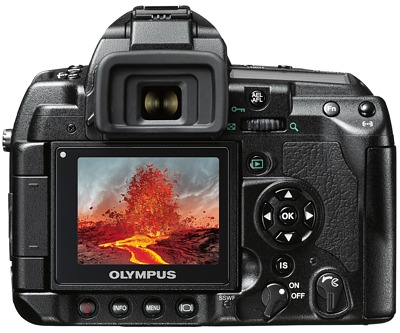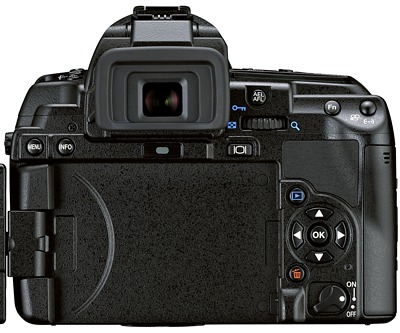
|
Olympus E-5 The E-3 Reloaded? |

|
My other articles related to the |
|
A swan song? Olympus has always been cautious and deliberate in introducing its flagship digital SLRs: first the revolutionary E-1 of 2003, then the E-3 of late 2007, reworked from the ground up, and now (more exactly, in January, 2010) the E-5. With the body construction and most of the specifications unchanged (or improved just a little), this may look like a minor, incremental update, but this is only partly true. In addition to the changes which are instantly visible (see the next section), the internal imaging engine has been significantly improved, and so was the entire Live View mode (adding sensor-based autofocus). Some people I trust see a significant improvement in image quality (which was outstanding in the E-3 anyway). The camera was highly anticipated by (mostly) Olympus users for a reason: with the company putting more and more resources in the development of the Micro Four Thirds line, many feared Olympus may be winding down its Four Thirds operations. In spite of three new (or not-so-new) models released in 2009, there were serious doubts regarding the survival of the Four Thirds line. The E-5 alleviated these concerns a bit, also providing at least one new, top-class body for those who invested into the Four Thirds lenses — among the best (but also often most expensive!) in the industry. In retrospect, when I'm cleaning up this article in 2013, we know that the concerns were justified: the E-5 was the end of the Four Thirds line. While the Four Thirds lenses can be used on Micro Four Thirds camera bodies (with an adapter), it is not quite the same: only some of them will actually autofocus (these are newer models, designed with Live View AF in mind), and even those which do, suffer in AF speed and accuracy, especially under low light. There is some hope — the upcoming E-M1 of the OM-D line. In this camera, there is a provision for phase-detection AF off the sensor surface; this may bring some of your Olympus glass investment back to life, but I will write more about it only after I try this option out. The new old body Both cameras share mostly the same magnesium alloy body (~800 g w/o battery; 143×117 mm), splash-proof and beautifully finished, which means that the E-5 is still missing the physical mode dial, my major complaint. When seen from the front, the new camera is indistinguishable from its predecessor:
|
| .t.jpg)
| .t.jpg)
|
Out with the old (E-3)...
|
...In with the new (E-5)
|
| The top deck also seems identical in both models; differences begin only when we have a look at the back, and they are due mostly to a significant increase in the monitor screen size: from 2.5 to 3 inches; obviously, this required some major reshuffling of external controls.
|
| 
| 
|
Changes in the camera back from the E-3 to E-5 (on the right). The picture shows the E-5 with the monitor folded out, too bad. Major control reshuffle can be seen.
|
| In spite of less space available for controls now, I like the new layout better than the old. First of all, the row of four identical buttons below the monitor is gone; this was one of my complaints about the E-3. The Menu and Info buttons are now at the far left, and the Live View one above the right end of the screen. Better. The Delete button (having nothing common with those three) is now under the cursor cluster (like in the '620), just fine with me. That spot was previously occupied by the IS mode button, which is now gone; fine, too, this is not a setting I'm changing often, and it can be easily accessed from the Control Panel. Last but not least, the battery cover release no longer occupies the valuable real estate on the camera back; it has been moved where it belongs: to the camera bottom. Oh, yes, the ambient light sensor was moved from the top left of the monitor box to the body proper, just above screen center. In the E-3, the automatic display brightness adjustment worked erratically for me, so I don't really care where the sensor is. Additionally, the thumb grip has been slightly re-sculpted because of less space available to the right side of the monitor New monitor screen The screen is not only larger (3"), but also has much better resolution: it changed from 230,000 RGB points (equivalent to 77,000 pixels) up to 920,000 (307,000 pixels); in other words, the linear resolution has been doubled. This is exactly what the Nikon D300 or Sony A700 have; nice, if not essential. Operational changes and refinements The new processing engine is referred to as TruePic V+ (as opposed to TruePic III in the E-3, but this means exactly nothing except that some changes have been made. Putting the names aside, let me try to enumerate the changes I was able to find.
Incremental improvements are also reported by users of the new camera; in particular, better tonality and dynamic range of generated images (there was nothing to complain here about in the E-3). Perhaps more importantly, the autofocus (phase-detection, SLR-type) has been made faster and more accurate; Olympus claims that in this department the E-5 is faster (at the time of its introduction) than any other SLR on the market. Having tried this camera with the 12-60 mm ZD lens, I find this claim plausible. A Digital Camera Review writer, after having tested the AF speed in the E-5 stated: "While I don't feel comfortable making the blanket statement that the E-5 has the fastest AF of any DSLR in the world, I can say that our lab tests show it currently has the fastest AF of any camera we've tested. The E-5 was able to obtain AF acquisition faster than the Nikon D300s, Canon EOS 7D or even the Canon EOS 1D Mark IV." (I believe this refers to the 12-60 mm ZD lens, others will, most probably, be slower.) Trinketry Here is a group of new features which I consider of marginal, if any, use in a camera like the E-5, addressed at an advanced-amateur or professional market.
So what now? In case you were waiting for my recommendations, these are not so easy to give. The E-5 is, no doubt, the best-performing Four Thirds (FT) camera (certainly to-date, possibly ever), and it may successfully compete with contemporary models from other makers, their higher pixel count notwithstanding. But does that justify a significant expense ($1700, body only), especially with the future of the system uncertain as it is? It is also big and heavy — a drawback for those who were attracted to Four Thirds by the promise of a smaller and lighter system. You will have to make your own decision here, but my advice, for those who ask, is:
As for myself, I am currently using the E-30 (for more critical applications) and E-620 (to save on size and weight, also as a backup body), so I am in the second group described above. The cameras work just fine and do not limit my photography in any way, so I decided to follow my own advice and wait to see what happens. Update of 2013: Last year I got an OM-D E-M5, a delightful μFT, EVF camera, and three lenses. This became my favorite all-around setup, although for more serious occasions I also take an E-30 along. The upcoming E-M1 may merge these two lines back together, so I'm glad I waited. Recommended Web resources I'm listing here just a few links to what I consider the most meaningful descriptions, reviews, or discussions of the E-5. In a random order, they are: | |||||||

|
My other articles related to the |
| This page is not sponsored or endorsed by Olympus (or anyone else) and presents solely the views of the author. |
| Home: wrotniak.net | Search this site | Change font size |
| Posted 2010/04/12; last updated 2013/11/18 | Copyright © 2010-2013 by J. Andrzej Wrotniak |